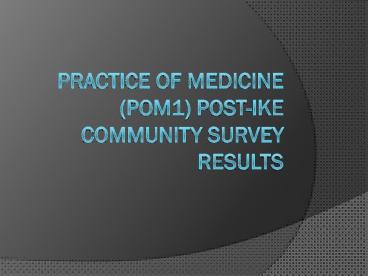Practice of Medicine (POM1) Post-Ike Community Survey Results - PowerPoint PPT Presentation
1 / 26
Title:
Practice of Medicine (POM1) Post-Ike Community Survey Results
Description:
Research Objectives ... Post-Ike Survey. Survey questions were selected from several previous post-disaster surveys. ... Surveys were conducted between February ... – PowerPoint PPT presentation
Number of Views:88
Avg rating:3.0/5.0
Title: Practice of Medicine (POM1) Post-Ike Community Survey Results
1
Practice of Medicine (POM1) Post-Ike Community
Survey Results
2
Background
- 1st year medical students are required to make
home visits to gain valuable interviewing skills. - The focus of this years survey was on
identifying loss and recovery issues related to
Hurricane Ike.
3
Human impact of disasters
- Disruption of social networks and displacement
- Housing and living conditions
- Economic costs (personal, community)
- Short-term physical and mental health effects
- Long-term physical and mental health effects
- All modulated by social and economic
inequalities, thereby producing disparities
4
Hurricane Ike Aftermath
Bicyclists ride past debris stacked on a seawall
road in Galveston, Texas, on September 14, 2008.
5
Ike Damage on Galveston Island
HOUSING approximately 40 of Island housing
uninhabitable, including 4 Public Housing
Developments numerous Section 8 rentals on
North Side Economy Downtown business district
inundated by 8-10 ft. of flood water from
Galveston Bay Channel Largest employer UTMB
sustains 800 million in damage eventually RIFs
3800 employees Vital Services Damage to City
infrastructure sewer, electricity, water UTMB
hospital loses ER, level 1 trauma center, 600 beds
6
Research Objectives
- Document the health, living and social conditions
experienced by families currently living on
Galveston Island - Identify specific needs of families currently
living in Galveston County - Compare the needs of victims of Hurricane Ike to
those of victims of other disasters
7
MethodologyPost-Ike Survey
- Survey questions were selected from several
previous post-disaster surveys. - Additional questions were added to respond
directly to the experiences of Galveston
residents. - Surveys were conducted between February and April
2009.
8
Post-Ike Survey
- Questions capture key community features
including - Housing and living conditions
- Child care
- Social support
- Health status
- Resident plans to remain in Galveston
9
Survey Findings
- Sample characteristics
- Total of 71 residents surveyed
- 67 female, 33 male
- 86 White, 6 Hispanic, 4 Asian
- 66 married, 13 divorced
- 32 college degree, 30 graduate degree, 32 H.S.
diploma/GED - 72 employed, 18 retired, 1 student, 1
homemaker, 1 employed but unable to return to
work post Ike - 100 reported having health insurance
10
Selected Pre-Ike Galveston Demographics vs.
Sample Demographics
11
Reported Health Problems
12
Reported Physical Health Status
- Nearly 68 reported good or excellent health
- 8 reported poor or fair health
- Nearly 23 reported that their physical health
has worsened since Hurricane Ike - 66 report that their physical health has not
changed since Hurricane Ike
13
Reported Mental Health Status
- 42 has had their mental health worsen since
Hurricane Ike. - 52 report that their mental health has not
changed since Hurricane Ike.
14
Access to Health Care
- Do you have access to health care?
15
Post-Ike Employment Status
16
Post-Ike Child Care Needsn26
17
Transportation Needs
18
Post-Ike Housing Conditions
- 84 of respondents have not moved out of their
home since Hurricane Ike - Almost 92 reported having working sewage
- 87 reported having working electricity
- 93 reported having working water
- 80 working gas
- 80 working phone
19
Post-Ike Housing Status
20
Residents Future Plans
21
Discussion
- Findings suggest community resiliency
- Minimal disruption and displacement
- Access to health care, health insurance, and
employment are vital to recovery process. - Familial social support is also key to recovery.
22
Limitations
- Training exercise for 1st year medical students
- Recruitment strategy not rigorous
- Little diversity exists within the sample
- Missing data
23
Limitations
- Findings are not generalizble to Galveston County
population - Findings do not address the experiences of
traditionally medically underserved populations.
24
Directions for future Surveys
- Future surveys should include a more
representative sample - No such thing as a natural disaster
- http//www.youtube.com/watch?vSEpis4JcySkfeature
PlayListpD57B961497B64FA4playnext1playnext_f
romPLindex17
25
Conclusions
- Access to health care and social support are
vital to community recovery. - This project provides insight into the interplay
of various social and economic factors which
could influence post-disaster recovery
experiences.
26
Acknowledgements
- We would like to extend our extreme gratitude to
Alyssa Blackburn who provided invaluable data
processing assistance.































